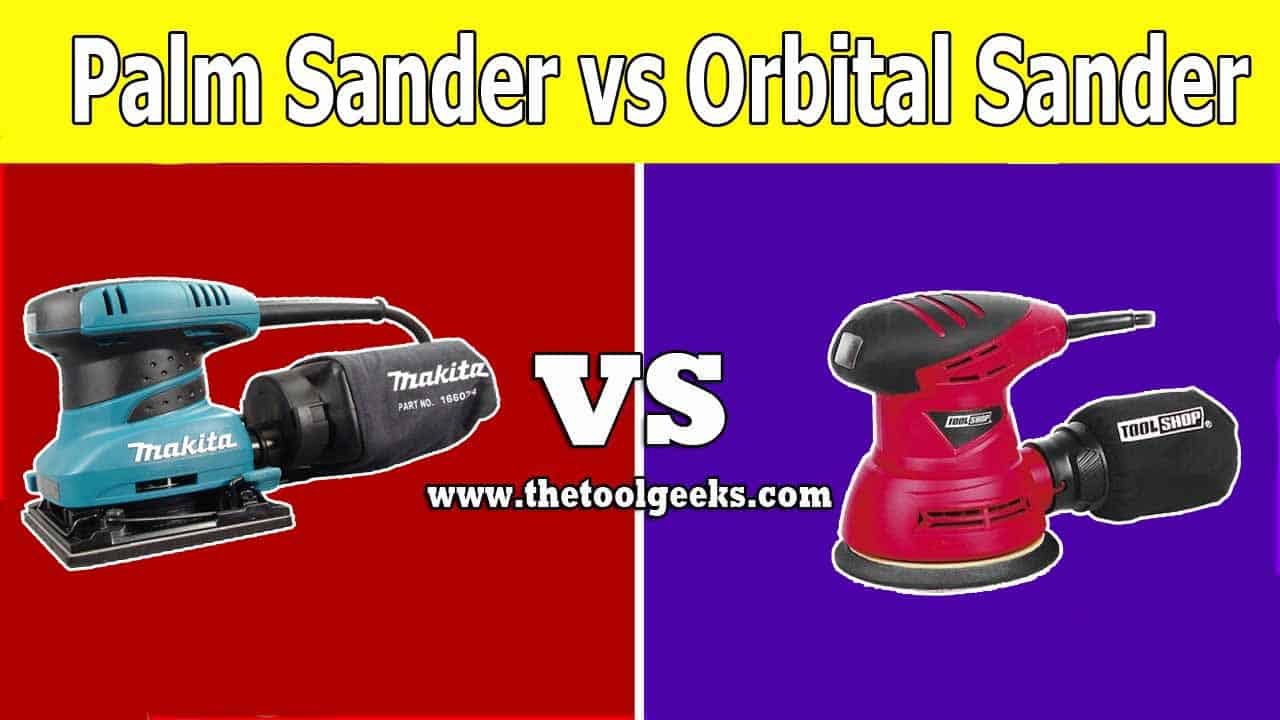Palm Sander Vs Orbital Sander – Which One is Best for You?
TheToolGeeks.com is a participant in the Amazon Services LLC Associates Program and other affiliate advertising programs. We may earn from qualifying purchases. (Learn More).
Palm sanders and orbital sanders are some of the most commonly used sanders in woodworking, home improvement, and painting projects.
The primary purpose of both sanders is the same, finishing the wood surface. But they differ in many ways, such as design, price, power, features, and usage.
Which one is best for you?
The best way to decide is to get a sander according to your project requirements.
To help you make an informed decision, we’ll palm sander vs orbital sander comparison, including which factors to consider and our recommended sanders.
Related Read — Best Sanders For Furniture
What Is an Orbital Sander and What Is It Used for?
Orbital sanders have a square-shaped sanding plate. Orbital sanders move, or spin, the sanding plate in small circles, or orbits, hence the name “orbital sander.” Their sanding plate sizes typically come in either ¼ or ½ inch sizes and use regular square-shaped sandpaper, available in many stores. They also have fairly powerful motors and are able to sand many types of wood.
Orbital sanders are popular because they are great on flat surfaces and they can reach tight corners and edges due to the flat and square shape of the sanding plate. Orbital sanders are versatile power tools and are made for sanding larger surface areas, such as doors, walls, and floors. They are popular with handy homeowners, contractors, and experienced woodworkers. Orbital sanders come in both corded (electrical) and cordless (battery-powered) models.
Orbital sanders are easily confused with random orbital sanders, as many hardware and home improvement stores will carry both orbital and random orbital sanders in the same section. While both orbital and random orbital sanders are both used for sanding wood, they have key differences.
Random orbital sanders have circular or disc-shaped sanding plates and they both spin and rotate the plate at the same time, resulting in a more elliptical or ‘random’ type sanding motion. Random orbital sanders also require circular or disc-shaped sandpaper, and the sandpaper usually attaches to the sanding plate via hooks and loops or Velcro-type straps. Now let’s check out palm sanders.
What Is a Palm Sander and What Is It Used for?
Palm sanders are smaller, lighter, and less powerful than orbital sanders, usually having ¼ inch or smaller, square-shaped sanding plates. The palm sander fits directly on your palm and can be operated with one hand, hence the name “palm sander.” They can also be called sheet sanders.
Palm sanders, like orbital sanders, use square-shaped sandpaper to sand wooden surfaces. This makes it possible to reach corners, edges, and tighter spaces with a palm sander, given its small structure and the shape of the sandpaper. Palm sanders, like orbital sanders, also come in both corded (electrical) and cordless (battery-powered) models.
If you want to sand a piece of furniture or a detailed wood piece or be able to hold the sander off the floor for longer periods of time, then the palm sander is your pick. The small size, however, can be a double-edged sword, as are limited to smaller-scale surfaces and tasks.
Palm sanders are popular in the hands of beginners, occasional users, and woodworkers that deal with precision work. While a palm sander is a versatile sanding tool, how good is it when compared to an orbital sander? Let’s find out.
Palm Sander vs. Orbital Sander – Detailed comparison
Although both sanders are popular and convenient for sanding multiple types of surfaces, they are different in their design, power, and usage.
And while Palm sanders can be considered orbital sanders as well, not all orbital sanders are palm sanders.
#1 Palm sander vs. orbital sander – which one is more powerful?
Power is one of the crucial factors you must consider while getting a sander for your needs. The power determines how well your sander suits the nature of the job. For example, you need a more powerful sander for a larger or rougher surface.
While both sander types have similar rotating or orbiting, speeds (measured in RPMs), generally, Orbital sanders have more powerful motors (measured in Watts) than palm sanders and cover more area. They can also remove more material than a palm sander.
See the below table with the Amperage and RPMs, and power of both sanders types (we took it from Amazon).
RPMs and motor amps (more amps means more power: P=VI) of orbital sanders:
| Sanders | Motor amps | Power (watt) | RPM |
| DEWALT Orbital Sander | 3 | 360 | 8000-12000 |
| CRAFTSMAN Orbit Sander | 3 | 360 | 12000 |
| SKIL 5″ Orbital Sander | 2.8 | 336 | 13000 |
RPMs and motor amps (more amps means more power: P=VI) of Palm sanders:
| Sanders | Motor amps | Power (watt) | RPM |
| BOSCH ROS20VSC Palm Sander | 2.5 | 300 | 7500-1200 |
| PORTER-CABLE Palm Sander 342 | 2.4 | 288 | 14000 |
| DEWALT Palm Sander (DWE6411K) | 2.3 | 276 | 14000 |
#2 Design
The design of the sander is an essential factor because it will help you determine whether your sander offers portability, stability, and ease of use while having enough power and RPMs to sand your surface.
An orbital sander features a square or rectangular plate where sandpaper attaches. The motor provides power to a gear that moves the plate. As a result, sandpaper rotates in circles or small orbits and provides finishing to the surfaces.
A palm sander also features a square, or rectangular plate and operates similarly to an orbital sander. But since it is smaller, it can be operated by one hand and usually doesn’t have a handle.
Related Read — Best Sanders For Stairs
#3 Weight
The weight determines how long you can hold the sander off the ground, such as on a furniture piece compared to a flat surface, as well as whether you can operate with one hand or need both.
The 5-inch orbital sander will be about 5 pounds, with a range of 4 to 6 pounds. The weight of a typical palm sander is usually around 1-1.5 pounds with a range of 1 to 3 pounds. Therefore, both are considered lightweight, compared to other power tools.
#4 Size
Again, the palm sander is smaller in size compared to the orbital sander. The large size of the orbital sander makes it more effective for larger and flatter surface areas, while the smaller size of the palm sander makes it more effective for smaller and more rounded surfaces and tighter areas.
Related Read — Best Sanders for Wood Pallets
#5 Surface area coverage
Now that we’re aware of the weight and size of palm sanders and orbital sanders. It’s clear that orbital sanders can cover a larger area for finishing.
But palm sanders are best for corners as they can easily cover places where it isn’t easy to do finishing with an orbital sander (due to its larger sanding plate size).
#6 Finishing comparison
Due to its large size and more powerful motor, the orbital sander is the best option for rough surfaces and large-scale projects.
On the other hand, palm sanders have less powerful motors. But palm sanders are best when you need detailed and precise finishing (not too rough) and dealing with small objects.
Related Read — Sander vs Planer
#7 Dust Collection
Being a larger sander, the dust collector unit you get with an orbital sander is bigger. Although, you will have to empty it continuously as the sawdust takes more space than sand or dirt.
#8 Price Comparison
Let’s compare the prices of both types of sanders (taken from Amazon) in the below tables.
Prices of Palm sanders:
| Sanders | Price |
| BOSCH ROS20VSC Palm Sander | $50-$80 |
| PORTER-CABLE Palm Sander | $80-$90 |
| DEWALT Palm Sander | $60-$70 |
Prices of orbital sanders:
Prices of orbital sanders:
| Sanders | Price |
| DEWALT Orbit Sander | $80-$85 |
| CRAFTSMAN Orbit Sander | $50-$70 |
| SKIL 5″ Orbital Sander | $45-$65 |
So, as far as prices are concerned, there is not a massive difference between palm sanders and orbital sanders. Prices may vary depending on the company, size, motor amps, etc.
Related Read — Sander vs Grinder
Orbital vs. palm sander – Which one is for you?
Your Task or Project Type
This is perhaps the biggest determinant of which sander to get. If you intend to sand a large or broad surface, then an orbital sander is your pick. If you will be working on a smaller surface, then you can go for the palm sander.
Besides the surface or project size, the type of finish want also matters. Orbital sanders are suited to sanding doors, walls, and floors, plus work like stripping finish or paint. If your goal is to achieve a very smooth and fine surface, such as on furniture or craft projects, and in tight corners, a palm sander should be your pick.
If you have a large-scale task on hand such as renovating your house, an orbital sander is better because it will be more versatile for different types of projects. And if your budget allows, both an Orbital and a Palm sander will enable you to cover all projects, large and small.
How Frequently Will You Be Using the Sander?
If you want a sander that you will only use occasionally, then choose a palm sander. But if you are an experienced handyperson that will need to sand regularly, an orbital sander will be the best choice for you.
Which one is best for beginners?
Again, both are ideal and can be used by beginners and experienced users alike. But the key point is to use them gently and allow the sander motor and plate to do the work. We generally would recommend using a palm sander if you’re a beginner because it will be gentle, lightweight, and provide smooth results.
Conclusion
Sanding is essential for home improvement, woodworking, shelf making, and any other surface that needs its material removed. When we talk about sanders, palm sanders and orbital sanders are some of the most popular and versatile electric sanders.
We’ve highlighted some differences and similarities between orbital and palm sanders. Though the final decision on which sander to get depends on you and your project requirements, we hope this post helps to make your decision easier.
If you have any questions or comments about the topic, please contact us and we’ll get to them as soon as possible.
Amazon and the Amazon logo are trademarks of Amazon.com, Inc, or its affiliates.

